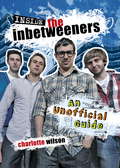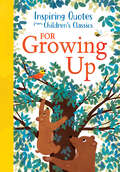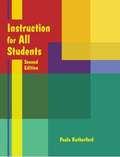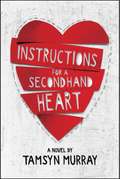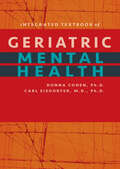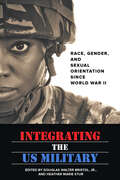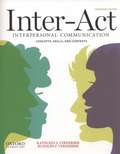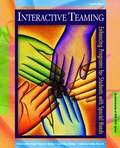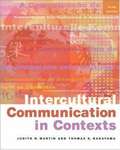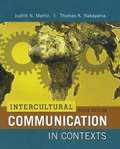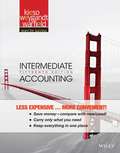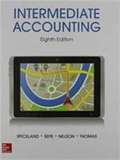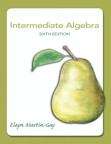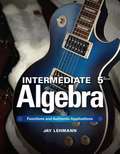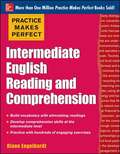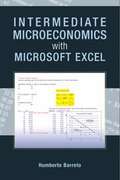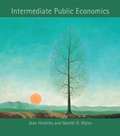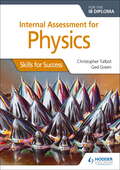- Table View
- List View
Inside the Inbetweeners: An Unofficial Full-colour Companion
by Charlotte WilsonThe Inbetweeners are Will, Simon, Neil and Jay - brought together at Rudge Park Comprehensive through their sheer lack of popularity, virginal status, and cringeworthy attempts to secure girlfriends...If you can't get enough of Will's pompous commentary, Simon's moody indecisiveness, Neil's dimwits and flatulence, or Jay's potty-mouthed boasting, then we have the very thing for you!This unique and unofficial guide brings you all the facts on the cast, both the characters and the actors behind them, comprehensive episode guides across all three series. A full listing on the music/tracks and artists featured in the show, hilarious quizzes, including Which Inbetweener Are You? and a fabulous pull-out poster of all four boys - TV's most unlikely pin-ups! Masses of colour photographs of the cast make this a must-have for teenagers of any age...
Inspiring Quotes from Children's Classics: For Growing Up (Inspiring Quotes from Children's Classics)
by Hannah BarnabyA delightful treasury of quotes to spark joy and imagination while growing up! This beautifully illustrated collection offers quotes from historical and modern classics for today's kids. Centered around helpful themes, such as courage, kindness, and self-confidence, these inspirational words from some of the most creative minds in children's literature offer readers timeless wisdom for growing up in today's world.Over 170 beloved children's books are found in this treasury, including:The Velveteen RabbitThe Wizard of OzCoralineRamona the PestJames and the Giant PeachTar BeachA Long Walk to WaterLast Stop to Market StreetLooking for Alaska"We are born to dream and make the things we dream about."—The Sun Is Also a Star, Nicola Yoon"Courage is if you knew where there were some mountains, you would definitely climb them."—Courage, Bernard Waber"You can't run away from who you are, but what you can do is run toward who you want to be."—Ghost, Jason Reynolds
Insta-glam: Your must-have make-up guide to get Instagram ready
by Hani Sidow'Muslim beauty blogger Hani Sidow is forging her own path, and it's inspiring' STYLISTLet beauty social media star Hani (@hanihanss) show you how to create 15 Instagrammable make-up looks.Hani's friendly and easy-to-follow make-up tutorials will help you create the perfect look every time. Unlock your selfie potential with 15 achievable styles covering everything from how to highlight and contour to creating the perfect nude lip, as well as picking up invaluable make-up hacks, such as using Sellotape to create the perfect winged liner, how you can make your lip colour last and why you should apply your make-up in the right light. Insta-glam wouldn't be complete without a quick tutorial on how to take the ideal selfie to show off your immaculately applied make-up. Find your best angle, pull the perfect pout, and get snapping!
Instruction for all Students: Second Edition
by Paula RutherfordThe second edition of this popular book is updated to reflect current research about best practice in teaching and learning in standards-based classrooms. In addition to resources for actively engaging students and multiple approaches to lesson and unite design, this text includes information on technology integration, formative assessment, 21st century thinking skills that promote rigor and relevance, and formats for job-embedded learning.
Instructions for a Secondhand Heart
by Tamsyn MurrayA moving novel about grief, guilt, and the unpredictability of love, for fans of Everything, Everything and All the Bright Places. Jonny knows better than anyone that life is full of cruel ironies. He's spent every day in a hospital hooked up to machines to keep his heart ticking. Then when a donor match is found for Jonny's heart, that turns out to be the cruelest irony of all. Because for Jonny's life to finally start, someone else's had to end. That someone turns out to be Neve's twin brother, Leo. When Leo was alive, all Neve wanted was for him (and all his glorious, overshadowing perfection) to leave. Now that Leo's actually gone forever, Neve has no idea how to move forward. Then Jonny walks into her life looking for answers, her brother's heart beating in his chest, and everything starts to change. Together, Neve and Jonny will have to face the future, no matter how frightening it is, while also learning to heal their hearts, no matter how much it hurts.(Features select illustrations from "Jonny's" sketchbook.)
Integrated Mathematics: Course 3 (Second Edition)
by Ann Xavier Gantert Edward P. KeenanThis Second Edition is offered to help students comprehend, master, and enjoy mathematics from an integrated point of view.
Integrated Textbook of Geriatric Mental Health
by Donna Cohen Carl EisdorferAs the population ages, increasing numbers of older people require the attention and services of mental health professionals. Despite their prevalence, however, mental health problems in this population often go undiagnosed and therefore untreated. This textbook offers medical students and professionals the information they need to care for older people with mental disorders.Drs. Donna Cohen and Carl Eisdorfer, two internationally recognized experts in geriatric mental health, provide a comprehensive framework within which students and practitioners alike can address the salient issues of the field. These include the biopsychosocial aging processes, specific pathologies prevalent in later life, social issues common to the elderly, the delivery of care in various settings, and the economic policies affecting services for older people. The authors’ goal is not only to enhance clinical practice but also to urge physicians to develop and coordinate a more holistic care strategy that acknowledges the complex challenges of older patients. To this end, Cohen and Eisdorfer discuss essential principles of optimal care, the latest research findings, evidence- and consensus-based practice standards, resources to help professionals keep abreast of the changing mental health landscape, and ethical dilemmas of clinical practice and research. The signal strength of this book lies in its integrated approach, an approach that emphasizes the philosophy and principles of caring for older people along with clinical practices and issues. From this broader perspective, the authors describe the many factors that influence the lives, health, and well-being of older patients and their caregivers, making this an ideal text for psychiatrists, psychologists, nurses, and social workers.
Integrating the US Military: Race, Gender, and Sexual Orientation since World War II
by Douglas Walter Bristol, Jr., and Heather Marie SturHow have the US Armed Forces been transformed by integration?One of the great ironies of American history since World War II is that the military—typically a conservative institution—has often been at the forefront of civil rights. In the 1940s, the 1970s, and the early 2000s, military integration and promotion policies were in many ways more progressive than similar efforts in the civilian world. Today, the military is one of the best ways for people from marginalized groups to succeed based solely on job performance.Integrating the US Military traces the experiences of African Americans, Japanese Americans, women, and gay men and lesbians in the armed forces since World War II. By examining controversies from racial integration to the dismantling of "Don’t Ask, Don’t Tell" to the recent repeal of the ban on women in combat, these essays show that the military is an important institution in which social change is confirmed and, occasionally, accelerated. Remarkably, the challenges launched against the racial, gender, and sexual status quo in the postwar years have also broadly transformed overarching ideas about power, citizenship, and America’s role in the world.The first comparative study of legally marginalized groups within the armed services, Integrating the US Military is a unique look at the history of military integration in theory and in practice. The book underscores the complicated struggle that accompanied integration and sheds new light on a broad range of comparable issues that affect civilian society, including affirmative action, marriage laws, and sexual harassment.
Intensely Alice: Dangerously Alice; Almost Alice; Intensely Alice (Alice #21)
by Phyllis Reynolds NaylorWouldn’t it be great to go back to the time before Pam got pregnant, before Patrick left for the University of Chicago, before anyone was making any big decisions about sex or college or life in general? Wouldn’t it be great to get the whole gang together again, just once? What it takes for this to happen will change Alice (and the whole gang) forever. A funeral is not a happy reunion. Full of life—the good, the bad, and the heartbreaking—this Alice book is a reminder of just how much can change in an instant.
Inter-Act: Interpersonal Communication Concepts, Skills, and Contexts (Thirteenth Edition)
by Rudolph F. Verderber Kathleen S. VerderberDesigned to help students understand communication processes in relationships and develop specific skills needed to create and maintain healthy ones, Inter-Act: Interpersonal Communication Concepts, Skills, and Contexts, Thirteenth Edition, retains the features that have made this book so successful: a theory driven skills-based focus, an accessible tone and presentation, and a multitude of useful pedagogical tools. For this edition, Joseph Mazer of Clemson University (whose scholarship includes original research on social media) authored much of the new and unique social media content and Brant Burleson and Erina MacGeorge of Purdue helped to update the scholarship, while maintaining the skills-based approach that this text is known for. Lively and well-written, Inter-Act features numerous activities that enable students to relate their everyday experiences to their studies in communication. It also clearly illustrates how cultural, racial, and gender differences-as well as electronically mediated messages-alter what we should do to communicate effectively. With a strong focus on the importance of ethics, this leading text encourages students to develop their analytical abilities as they think critically about key concepts in interpersonal communication.
Interactional Supervision
by Lawrence ShulmanInteractional supervision models explained, applying supervision during the phases of work, education and evaluation roles of the supervisor, and working with staff groups.
Interactive Teaming: Enhancing Programs for Students with Special Needs (4th edition)
by Vivian Ivonne Correa Hazel Jones Carol Chase Thomas Catherine Voelker MorsinkInteractive teaming in special programs is a concept of service delivery for school-age students who are currently placed in special education programs or are at risk for referral to such programs.
Intercultural Communication in Contexts (3rd edition)
by Judith N. Martin Thomas K. NakayamaAn in-depth look at the cultural context of communicating both with silence and speech.
Intercultural Communication in Contexts (6th Edition)
by Judith N. Martin Thomas K. NakayamaWith the rapid expansion of globalization, intercultural contact is now part of daily life for most of us. Intercultural Communication in Contexts examines communication in multicultural relationships and provides practitioners with the tools for effective communication amid cultural, ethnic, and religious differences. Students are introduced to the primary approaches for studying intercultural communication along with a theoretical and practical framework for applying these approaches themselves.
Interference (Arthur A Levine Novel Bks.)
by Kay HoneymanFriday Night Lights meets Jane Austen's Emma in this wonderful novel about a big election, big games, the big state of Texas, and a little romance.As a Congressman's daughter in Washington, D.C., Kate Hamilton is good at getting what she wants -- what some people might call "interfering." But when her family moves to West Texas so her dad can run in a special election, Kate encounters some difficulties that test all her political skills. None of her matchmaking efforts go according to plan. Her father's campaign gets off to a rough start. A pro tip for moving to Texas: Don't slam the star quarterback's hand in a door. And whenever Kate messes up, the irritatingly right (and handsome) Hunter Price is there to witness it. But Kate has determination and a good heart, and with all her political savvy -- and a little clever interference -- she'll figure out what it takes to make Red Dirt home. Terrifically funny and sweetly romantic, with whip-crack dialogue and a wise perspective on growing up, Interference is the perfect next read for fans of Jenny Han, Huntley Fitzpatrick, Elizabeth Eulberg, or Sarah Dessen.
Intermediate Accounting (Fifteenth Edition)
by Donald E. Kieso Terry D. Warfield Jerry J. WeygandtKieso, Weygandt and Warfield's Intermediate Accounting continues to set the standard for intermediate accounting students and professionals in the field. The Fifteenth edition builds on this legacy through new innovative student focused pedagogy in the book itself and with online support. Kieso maintains the qualities for which the text is globally recognized, including its reputation for accuracy, comprehensiveness, accessibility, and quality problem material that best prepares students for success on the CPA exam. The Fifteenth edition offers the most up to date coverage of IFRS and US GAAP in a presentational format suited to the complex challenges of teaching intermediate in these changing times. The WileyPLUS homework and learning platform (access to WileyPLUS sold separately) is better than it has ever been for Kieso, with a multitude of new assessment items, multimedia resources, and enhanced functionality to ensure students will do real accounting and get real results. There have also never been so many options for accessing content, from several online only options, premium value print and digital formats, and custom versions designed to fit your needs perfectly.
Intermediate Accounting Eighth Edition
by J. David Spiceland Wayne B. Thomas Mark W. Nelson James F. SepeFinancial accounting is undergoing a period of unprecedented change. The FASB and IASB have been working together to issue converged accounting standards that will dramatically change key reporting areas, and more generally have sought to converge accounting standards over time. However, at present the convergence process appears to have stalled with respect to new standards, and it is not clear when, if ever, IFRS will be fully incorporated into U. S. GAAP. So, while there is considerable overlap between U. S. GAAP and IFRS, important differences between U. S. GAAP and IFRS will remain for the foreseeable future. To help instructors deal with this very challenging environment, the Spiceland team is committed to providing current, comprehensive, and clear coverage of intermediate accounting, and the eighth edition reflects this.
Intermediate Algebra
by D. Franklin WrightIntermediate Algebra (sixth edition) provides a solid base for further studies in mathematics. In particular, business and social science majors who will continue their studies in statistics and calculus will be well prepared for success in those courses. With feedback from users, insightful comments from reviewers, and skillful editing and design by the editorial staff at Hawkes Learning Systems, we have confidence that students and instructors alike will find that this text is indeed a superior teaching and learning tool. The text may be used independently or in conjunction with the software package Hawkes Learning Systems: Intermediate Algebra developed by Quant Systems.
Intermediate Algebra
by Margaret L. Lial John Hornsby Terry McginnisStudents who have never studied algebra--as well as those who require further review of basic algebraic concepts before taking additional courses in mathematics, business, science, nursing, or other fields--will benefit from this textbook.
Intermediate Algebra: Functions & Authentic Applications
by Jay LehmannIn this course, you will learn not only more about algebra but also how to apply algebra to describe and make predictions about authentic situations.
Intermediate English Reading and Comprehension
by Diane EngelhardtTake your skills to the next level and get moremeaning out of the English language Reading English texts that are created especially for ESL students like you is a critical part to learning the language, but that does not mean you have to be bored with the subjects! Created by expert ESL instructor Diane Engelhardt, Practice Makes Perfect: Intermediate English Reading and Comprehension features 15 engaging readings on interesting topics such as the technology of 21stcentury deep-sea treasure hunting, Pixar Studios'computer-generated movie magic, the Flying Doctors of Australia, and more. You will, of course, get plenty of practice, practice, practice on understanding and comprehending vocabulary. You'll master how to read for main ideas, summarize texts, make outlines, remember facts and figures, and more. Before you know it, your reading skills will be stronger and your comprehension will grow, enabling you to get more out of English-language texts. Practice Makes Perfect: Intermediate English Reading and Comprehension will help you: Develop your reading comprehension skills at theintermediate level Build your English vocabulary Prepare for the comprehension sections of ESL tests
Intermediate Microeconomics With Microsoft Excel
by Humberto BarretoThis unique text uses Microsoft Excel® workbooks to instruct students. In addition to explaining fundamental concepts in microeconomic theory, readers acquire a great deal of sophisticated Excel skills and gain the practical mathematics needed to succeed in advanced courses. In addition to the innovative pedagogical approach, the book features explicitly repeated use of a single central methodology, the economic approach. Students learn how economists think and how to think like an economist. With concrete, numerical examples and novel, engaging applications, interest for readers remains high as live graphs and data respond to manipulation by the user. Finally, clear writing and active learning are features sure to appeal to modern practitioners and their students. The website accompanying the text is found at www.depauw.edu/learn/microexcel.
Intermediate Public Economics
by Jean Hindriks Gareth D. MylesPublic economics studies how government taxing and spending activities affect the economy--economic efficiency and the distribution of income and wealth. This comprehensive text in public economics covers the core topics market failure and taxation as well as recent developments in the political economy and public choice literatures. It is unique not only in its broad scope but in its balance between public finance and public choice and its combination of theory and relevant empirical evidence. After introducing the theory and methodology of public economics and reviewing the efficiency of the competitive equilibrium, the book presents a historical and theoretical overview of the public sector. It then discusses departures from efficiency, including imperfect competition and asymmetric information; issues in political economy, including rent-seeking (a topic often omitted from other texts); equity; taxation issues, including tax evasion and its consequences; fiscal federalism and tax competition among independent jurisdictions; and the intertemporal issues of social security and economic growth. This text introduces the reader to the theory of public economics and the most significant results of the analysis, providing an overview of the current state of the field. It is accessible to anyone with a background of intermediate microeconomics and macroeconomics and can be used in advanced undergraduate as well as graduate courses. Although the mathematics has been kept to a minimum, the book remains analytical rather than discursive. Annotated suggestions for further reading and numerous exercises are included at the end of each chapter.
Internal Assessment Physics for the IB Diploma: Skills for Success
by Christopher TalbotExam board: International BaccalaureateLevel: IB DiplomaSubject: PhysicsFirst teaching: September 2021First exams: Summer 2023Aim for the best Internal Assessment grade with this year-round companion, full of advice and guidance from an experienced IB Diploma Physics teacher.- Build your skills for the Individual Investigation with prescribed practicals supported by detailed examiner advice, expert tips and common mistakes to avoid.- Improve your confidence by analysing and practicing the practical skills required, with comprehension checks throughout.- Prepare for the Internal Assessment report through exemplars, worked answers and commentary. - Navigate the IB requirements with clear, concise explanations including advice on assessment objectives and rules on academic honesty.- Develop fully rounded and responsible learning with explicit reference to the IB learner profile and ATLs.
